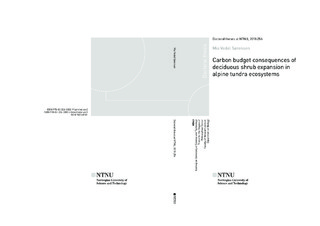Carbon budget consequences of deciduous shrub expansion in alpine tundra ecosystems
Doctoral thesis
Permanent lenke
http://hdl.handle.net/11250/2565086Utgivelsesdato
2018Metadata
Vis full innførselSamlinger
- Institutt for biologi [2604]
Sammendrag
Arctic and alpine tundra ecosystems are important for global carbon sequestration, as they store more than half of the global soil carbon (C), and these systems are predicted to have the greatest soil C loss following climate warming. Deciduous shrub cover has increased in tundra ecosystems during recent decades, but herbivory can counteract this. An open question is how shrub expansion will affect the carbon balance of these ecosystems? Where some studies predict increased ecosystem C storage with shrub expansion because of more vegetation biomass, a growing body of literature indicate that shrubs release soil C through below-ground processes. The overall aim of this thesis was to investigate how deciduous shrub expansion affects the growing season ecosystem CO2 fluxes and C pools in an Empetrum-dominated heath, an herb-and cryptogam-dominated meadow, and a Salix shrub-dominated community in Dovrefjell, Central Norway. Additionally, experimental treatment effects of exclusion of small and large herbivores together with planting of small Salix plants was measured, and abiotic and biotic drivers of C dynamics identified.
The results from this thesis indicate how shrub expansion into low statured alpine tundra communities may influence the summer C cycling differently depending on plant community. Also, soil C pools might decrease due to below-ground differences and processes happening outside of the growing season. In this way, shrub expansion into alpine ecosystems might contribute to increased atmospheric CO2 through a net CO2 release from below-ground pools. Sammendrag:
Hvordan påvirker gjengroing av kratt og buskvekster karbonsyklusen på fjellet?
Mer enn halvparten av det globale karbonlagret finnes lagret i jorden i alpine og arktiske tundraer. Økte temperaturer i tundraens økosystemer som en konsekvens av klimaendringer kan derfor føre til frigjøring av karbon fra disse store lagrene.
Tundraens økosystemer har de siste tiårene endret seg ved at det har blitt mer og større kratt og buskvekster, men økt beiting kan bidra til å minske denne gjengroingen.
Hittil har forskning vist motstridende resultater om hvordan denne gjengroingen påvirker karbonbalansen i disse økosystemene. Noen studier mener at gjengroing bidrar til økt karbonlagring som følge av mer biomasse, mens andre tyder på at buskene via underjordiske prosesser heller frigir karbon bundet i jorden. Formålet med denne avhandlingen var å undersøke hvordan gjengroingen av fjellet påvirker syklusen og lagrene av karbondioksid i tre ulike plantesamfunn på Dovrefjell. Dette ble gjort ved å undersøke hvordan eksklusjon av beiting og planting av vierplanter påvirker disse prosessene i ei kreklinghei, en eng og et vierkratt. Vi undersøkte også hvilke abiotiske og biotiske faktorer som har størst påvirkning på karbonsyklusen i disse tre områdene.
Resultatene tyder på at avhengig av plantesamfunnet kan gjengroing føre til ulike endringer i karbonsyklusen midt i vekstsesongen, men karbonlagringen i jorda kan avta på grunn av abiotiske og biotiske faktorer i jorden utenfor vekstsesongen. Økt gjengroing ved større og flere kratt og buskvekster kan dermed føre til frigjøring av karbon og bidra til økte nivåer av karbondioksid i atmosfæren.
Består av
Paper 1: Sørensen, Mia Vedel; Strimbeck, Richard; Nystuen, Kristin Odden; Kapás, Rozália Erzsebet; Enquist, Brian J.; Graae, Bente Jessen. Draining the Pool? Carbon Storage and Fluxes in Three Alpine Plant Communities. Ecosystems 2017 ;Volum 21.(2) s. 316-330 https://doi.org/10.1007/s10021-017-0158-4Paper 2: Sørensen, Mia Vedel; Graae, Bente Jessen; Hagen, Dagmar; Enquist, Brian J.; Nystuen, Kristin Odden; Strimbeck, Richard. Experimental herbivore exclusion, shrub introduction, and carbon sequestration in alpine plant communities. BMC Ecology 2018 s. 18-29 - Final published version available at https://doi.org/10.1186/s12898-018-0185-9 This article is distributed under the terms of the Creative Commons Attribution 4.0 (CC BY 4.0)
Paper 3: Strimbeck, Richard; Graae, Bente Jessen; Lang, Simone I.; Sørensen, Mia Vedel. Functional group contributions to carbon fluxes in arctic-alpine ecosystems. The final published version is available in Arctic, Antarctic and Alpine research 2019 ;Volum 51.(1) s. 58-68 https://doi.org/10.1080/15230430.2019.1578163 This article is distributed under the terms of the Creative Commons Attribution 4.0 (CC BY 4.0)
Paper 4: Sørensen, Mia Vedel; Graae, Bente Jessen; Classen, Aimee; Enquist, Brian J.; Strimbeck, Richard. Biotic and abiotic drivers of C cycling in three alpine-arctic tundra plant communities: potential mechanisms The final published version is available in Arctic, Antarctic and Alpine research 2019 ;Volum 51.(1) s. 128-147 https://doi.org/10.1080/15230430.2019.1592649 This article is distributed under the terms of the Creative Commons Attribution 4.0 (CC BY 4.0)
